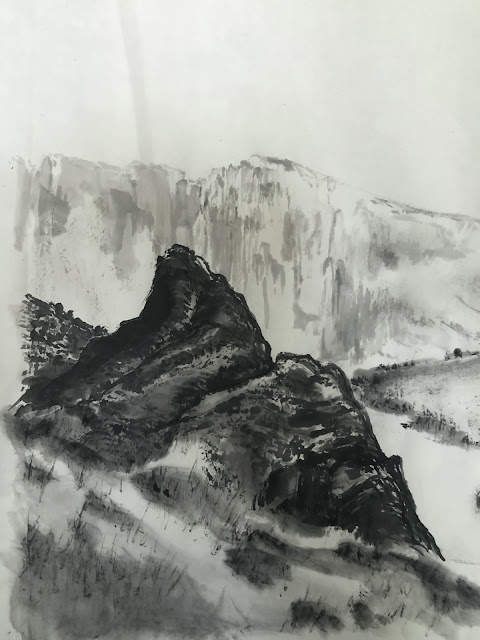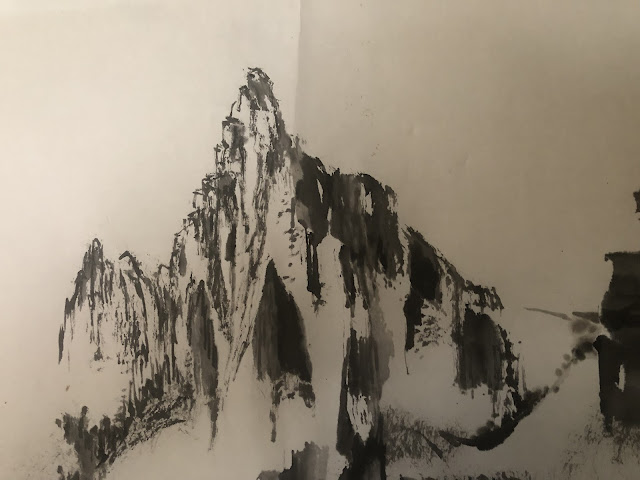I am an enthusiast of Chinese Brush Painting and I would like to share my trials and tribulations in learning the craft. I want to document the process, the inspiration and the weird ideas behind my projects and to address some of the nuances related to this dicipline. I hope to create a dialogue and stir up some interest in the art of painting with a Chinese brush on Xuan. In any case, it would be interesting to see my own evolution as time progresses. This is my journal
Friday, March 17, 2023
Waste Basket Diving
Wednesday, March 1, 2023
Paint for the waste basket
It's time to put my game on, tackling my mosaic project. I really can't let a 9 nine old show me up, can I?
I am using a semi-sized Xuan because it is thin enough to facilitate the copying process. I will need to trace my stencil with a brush only this piece of paper. I suppose I can trace it out with pencil first to get all the pieces and then cover up the pencil lines with ink brush once the painting is done, but I don't have the patience for it. The bottom line is I hate to do the same thing twice; tracing my stencil is already a chore for me.
Using the same logic, I pick out other pieces of my "mosaic' and address them with different colors.
I am assigning a deeper, darker color to the right half of my composite.
Friday, July 8, 2022
Yet another landscape
After my attempt at painting Chibi (the red cliffs) I want to try my luck on another landscape painting, with cliffs or stony features as my main player; again. Whereas the Chibi painting was sort of dreamy and poetic, I intend for the current production to be more hard and staunch in character.
For this attempt I am mixing my ink with alum solution to paint on traditional Xuan paper. The slight bleeding from the brushstrokes allows the paper the stage to express soft strokes. Alum working as a mordant tends to eliminate that quality by fixing the ink before it has a chance to escape into the microfibers of the paper. I am looking for harsher brushstrokes to help depict the rocky texture of my intended landscape.
My model comes from the central part of Oregon where it is a little less lush with greenery but more abundant with rocky outcrops and mesas. The Deschutes River and the Crooked River are landmarks that inspire me, so I shall use them as my references and give the Columbia River Gorge a pass.
First item on the list is a rocky structure occupying the left side of the painting. I suppose I've not found my rhythms yet and the brushstrokes feel very contrived. Of course the remedy for my shortcoming is to immediately paint the background with diluted ink and loose brushstrokes without the alum as a conspirator, thus the markings are much more relaxed.
Contrasting with the hard edges of the rocky structure are not only the diluted ink for the distant hills, but also the soft non-discrete foreground, as if the camera is out of focus and the viewer is using the bokeh to frame their image in the head.
The center portion of my painting is taken up by the sharp, chiseled rocks of the landscape.
The alum/ink mixtures helps to cement the brushstrokes before they have a chance to bleed; offering a stern appearance.
An assortment of line chuen, akin to the hemp chuen is used to doll up and texturize the non-rocky parts of the landscape. I mean, if Monet and Van Gogh can employ dots and lines to fashion their works, why can't I, right? Actually the dot and line chuen technique has been in practice in Chinese brush techniques since antiquity, I am just making light of them.
Sunday, March 31, 2019
Will Epsom Salt Work
I typically would paint on the back side of the paper with a alum infused brush. The brushstroke will reveal a clear margin when a different color is painted over it; as long as that color is not too strong to obscure the margin.
Here's an example of the margin
I've also used this technique to create a blurry image by first painting with alum on the reverse side of the paper, allowing the brushstroke to show through the top side. I then go over the top side with a darker color, being careful to not totally obscure the original brushstroke on the back side. The resulting image has that interesting back lit effect and suggests a 3 dimensional perception, especially when viewed from a distance, or by squinting one's eyes.
Here's another example of painting done with alum solution. Its role in making the paper less absorbent is exploited to the extreme by functioning as a masking fluid. It was used to paint in the snow. Obviously it is well suited for high contrast work like this one.
I was contemplating painting a desert scene and I was interested in a novel way to depict the wind generated ridges on the sand dunes. I didn't want to paint these wavy ridges with hard ink brushstrokes. I therefore turned to my secret solution and envisioned the clear margins left by such brushstrokes would be more enigmatic and evoke more drama in my painting.
But I ran out of my Ancient Chinese Secret Solution.
I resorted to my daft antics.
I recall a leftover bag of Epsom salt from when I sprained my ankle. Epsom salt is magnesium sulfate. Could I substitute Epsom Salt for Alum, which is aluminum and potassium sulfate. I recall reading about using copper sulfate as a mordant, so why not magnesium sulfate?
I rolled up my sleeves and went to work. I prepared a saturated solution of Epsom salt. My experiment involved painting with the Epsom salt solution in raw and semi-sized Xuan. I painted on the top side of the paper, and on the back side of the paper to see if the reveal is different.
Here is the result of painting on regular raw Xuan. The top image is painting the Epsom salt solution on the top side of paper; bottom image is painted on the back side.
Here is the result of painting on semi-sized Xuan. This paper is less apt to absorb liquid because of the sizing, therefore I wanted to see what effect my concoction will have, if any.
So when applied to the top side of the semi-sized Xuan (top image) Epsom salt seems to have a smidgen of effect. I think I can make out a semblance of a faint margin.
As you can see, Epsom salt solution failed as a candidate for alum substitution.
I know what will be on my shopping list now.
Wednesday, August 3, 2011
Multnomah Falls Impression
Not everybody has been to the Falls or seen pictures of it. So I decided to play it up a little. I used blue streaks to create the upper cliffs. The streaks were done so that they themselves resemble moving water.
The blue wash was mixed with alum applied side tip fashion onto Xuan. Alum functions as a sizing
agent, helps to delineate the brush strokes; makes the brush strokes more vivid in the sea of blue wash. Thus we have a laminar flow of blue ribbons, rounding the corner to flow into the hour-glass void below. A grayish overlay is then applied over the blue streaks. The grey wash was again created by using alum solution as diluent. This was done to prevent the wash from totally blending into one big flat surface. I wanted stroke marks to show up a little better, simulating the horizontal crevasses in the cliff wall. These marks also helped to suggest interruptions in the stream ( even though the grey area is not the stream ) and gave an illusion of motion.
The actual narrow ribbon of upper fall was again painted with alum first to establish a base layer of resist, to ward off as much unintended seepage of wash as possible. At the head of the upper fall, I just held my brush and waited for the color to slowly bleed out to the desired spaces before moving on. This controlled osmosis when executed alongside of alum sizing will create some artifacts that will indulge your ocular senses.
The hour-glass void represented the lower fall. Its shape was inspired by the exaggerated proportion of a woman's body. Imagine Marilyn Monroe coming at you with open arms, donning a black cape. Get the picture now?
The lower fall is flanked by bold side tip brushstrokes. This was my interpretation of the near scape of the land. The hour glass shaped lower fall was again defined by the use of alum. I was careful to not make the entire structure black. I took time to make sure I leave some white slivers in them, so they can breathe.
I wish I had done the bridge in a more Xieyi fashion. More nonchalant, more expressive. Right now it looked too stiff. I was pushing it too much.
There you have it. Multnomah Falls, Impression!
































